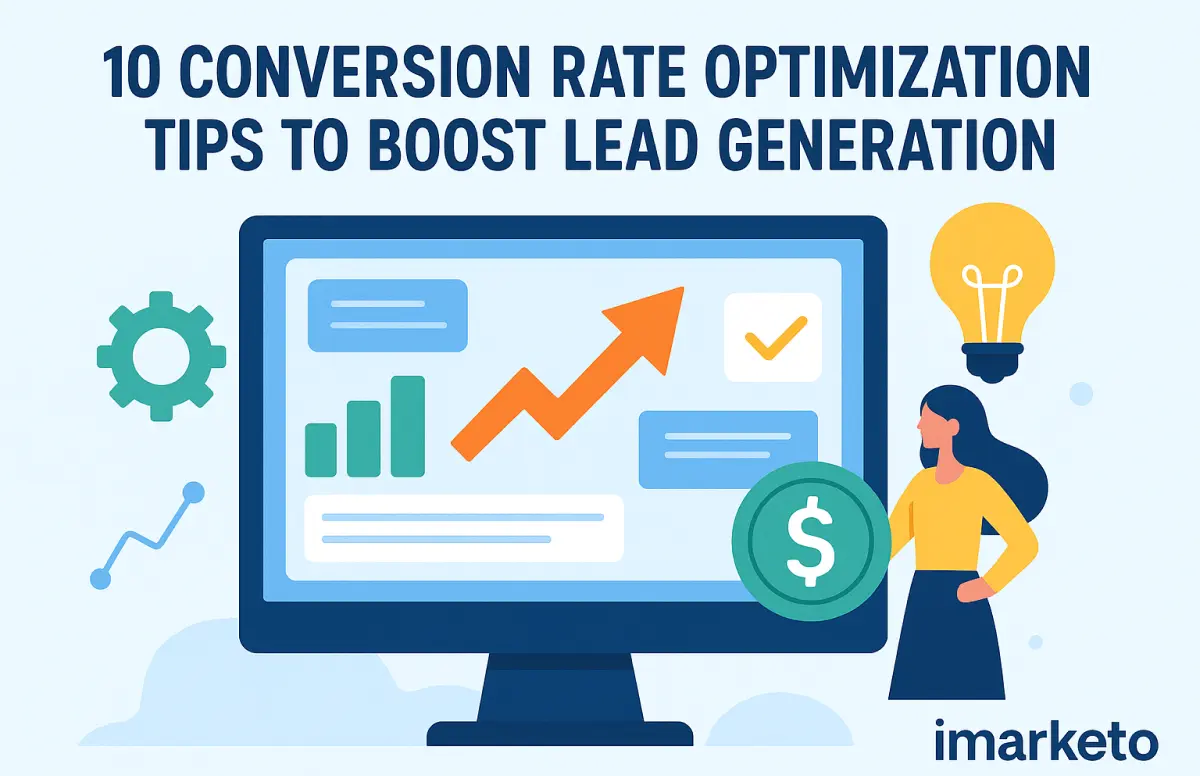
10 Conversion Rate Optimization Tips to Boost Lead Generation
August 15, 2025
Less than 3% of visitors to business websites become leads. This shows that 97 out of 100 prospective clients are leaving without interacting.
The issue is typically that the website isn't optimized to direct users to the next step, not the quality of the traffic or even the product.
Businesses that are competent at conversion optimization not only increase their lead generation, but also improve it, lower their costs associated with acquiring new customers, and create more steady sources of income.
Here are 10 proven strategies that can dramatically improve your website's lead generation performance.
1. Headlines That Address Pain Points
Your headline is often the first thing visitors see, and it might be the only thing they read before choosing to stay or go
Instead of talking about what you do, focus on what your visitors get or how their situation improves after working with you.
Use simple language like “Get a free demo,” “Start saving time,” or “Generate more qualified leads.”
Thier are tools like Unbounce, Optimizely, Google Optimize that helps in optimising the headlines and copy.
2. Optimizing Lead Capture Forms for Maximum Conversions
Leads are generated from interested visitors using lead capture forms. The secret is finding a balance between obtaining relevant data and making this process easy enough for people to finish.
Test form length vs. lead quality to find your sweet spot. Limit initial forms to 3-5 essential fields maximum. Test single-column vs. multi-column layouts
Tools like HubSpot Forms, Typeform, Formstack, ConvertKit helps to optimise lead forms with advanced form customization options.
3. Social Proof to Build Trust and Credibility
Social proof increases trust that your solution is effective and lowers the perception of risk. Social proof that works is precise, reliable, and relevant to the needs of your target audience.
User-generated content, case studies, client logos from well-known businesses, and specific customer success stories with measurable results are examples of high-converting social proof.
Tools like Trustpilot, Testimonial Hero, Boast helps in social proof and testimonial management with embeddable widgets.
4. Clear and Compelling Call-to-Action Buttons
Effective CTAs use action-oriented language that tells visitors exactly what happens next and what benefit they'll receive. They should stand out visually while fitting naturally into the page flow.
CTA optimization can be done by using precise, benefit-focused button text, experimenting with various sizes, colors, and wording, and making sure that mobile interfaces are optimized for touch screens.
Tools like OptinMonster, Google Analytics, Crazy Egg can help in optimising CTA placement and design.
5. Urgency and Scarcity Without Being Manipulative
Real deadlines, limited supply, or time-sensitive offers are examples of authentic urgency. The key is communicating these constraints clearly while focusing on the value customers will miss if they don't act promptly.
Some strategies to help create a sense of real urgency and scarcity include limited-time promotions with actual expiration dates, seasonal availability or capacity constraints, and early-bird pricing for events or launches.
Tools like Scarcity Samurai, OptinMonster, ConvertBox helps in Lead generation with countdown timers and scarcity elements.
6. Optimize Page Loading Speed
In addition to improving user experience, speed optimization raises search engine rankings and lowers advertising expenses by raising quality scores
database queries and server response times, image optimization and compression, and superfluous plugins and scripts.
Tools like Google PageSpeed Insights, GTmetrix, WebPageTest helps in optimising the page speed.
7. Design Mobile-First Website
Mobile optimization is more than just responsive design. Smaller screens, touch interfaces, and browsing while on the go require a complete redesign of the user experience.
Simplifying navigation and reduce menu complexity, minimising form fields and streamlining checkout processes. Website Optimization is crucial for lead gen
Tools like Google Mobile-Friendly Test, Mobile Moxie, BrowserStack helps in mobile optimization.
8. Leverage Exit-Intent Technology
Offering real value instead of pushy sales pitches is crucial. Address the potential causes of people's departures and offer solutions that will motivate them to continue participating.
Valuable lead magnets, coupons for first-time purchases, seeking feedback, and appealing newsletter subscriptions with special content are a few examples of effective exit-intent strategies.
Tools like OptinMonster, Privy, Justuno, ConvertFlow helps in Popup Optimization.
9. A/B Test Everything to Make Data-Driven Improvements
A/B testing doesn't need complex tools or a lot of traffic. As you collect data, test more subtle changes gradually after starting with high-impact components like headlines, calls to action, and form designs.
Headlines and subheadings are examples of high-impact elements. It is necessary to test the form fields, layout, images, and visual components first.
Some Conversion Optimization Platforms like Optimizely, Unbounce, Google Optimize, VWO, Convert helps in A/B Testing.
10. Track and Analyse User Behaviour
Headlines and subheadings are examples of high-impact elements in SEO. It is necessary to test the form fields, layout, images, and visual components first.
Click patterns and attention hotspots, form interaction and abandonment points, behavioural differences between mobile and desktop devices, and navigation patterns and user flows are some important behavioural insights to monitor.
User Behaviour Analysis and Heatmap Tools are Hotjar, FullStory, Microsoft Clarity, Crazy Egg.
Conversion Optimization Roadmap
Keep in mind that conversion optimization is a continuous procedure rather than a one-time activity. Markets shift, consumer behaviour shifts, and new opportunities appear all the time. Businesses that never stop testing and improving are the ones that regularly outperform their competition.
Determine your largest conversion bottlenecks first. Determine where most visitors leave your site using analytics data, then concentrate your optimization efforts there first.
With a few calculated adjustments, it can become a much more powerful lead generation tool that generates more qualified leads and, eventually, more income.
Leave a Reply